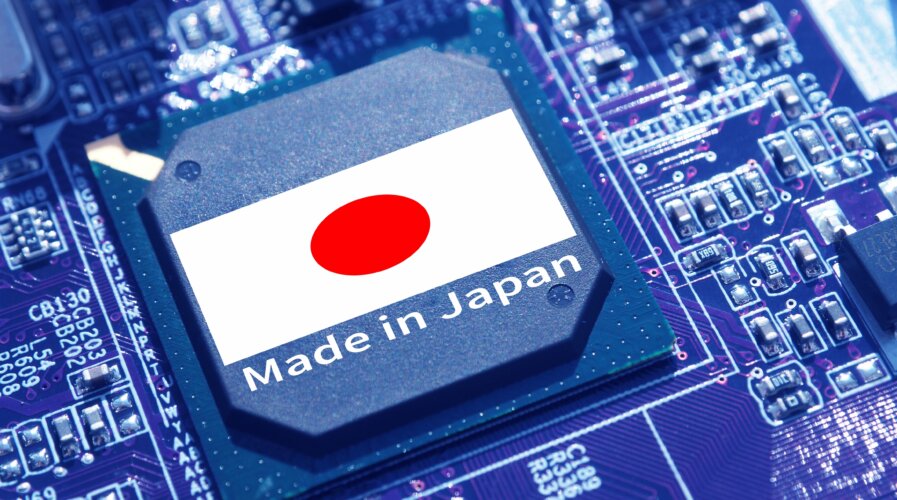
Japan revamped its semiconductor strategy as competition and geopolitical tensions heightenedSource: Shutterstock
Japan revamps semiconductor strategy as competition and geopolitical tensions heightens
- Japan has tripled its semiconductor sales goal.
- The country may struggle to meet its target due to restrictions on relevant exports.
Since the early 2000s, the Japanese government and domestic semiconductor companies have been reflecting on why the country’s chip industry has been losing ground to foreign competitors. Countless efforts were put in place to revive global interest in Japan’s stalled chip sector over the last two decades.
Following a lost decade in the 2010s, when Japan still failed to invest in its once-thriving industry, the government released a semiconductor strategy in 2020. It set a goal of 5 trillion yen in sales of domestically produced semiconductors by 2030. That was three years ago. This week, Japan released a revised strategy for its chip industry, including an ambitious sales goal.
According to the strategy, the country aims to increase sales of semiconductors to more than 15 trillion yen (US$108 billion) by 2030, tripling the 2020 figure. The plan is part of Japan’s strategy to put chips at the center of its economic security policy.
Here’s the revised semiconductor strategy plan for Japan
According to Japan’s Ministry of Economy, Trade and Industry (METI), the revised strategy, released on June 6, aims to strengthen efforts to develop and produce advanced semiconductors critical for economic security measures and advanced technology like generative AI.
The strategy also stated that the sales target for firms that make chips in Japan would help secure a stable supply of semiconductors for the nation. “Various investments are being made by Japanese chip-related companies, including smaller ones, and we’d like to back up these investments,” economy minister Yasutoshi Nishimura told reporters before the strategy’s release.
“We want to secure the necessary budget to support these efforts.” The 274-page strategy, however, didn’t say how much the government plans to dole out over the coming years in addition to the billions of dollars already in place to encourage Taiwan Semiconductor Manufacturing Co. to add production capacity and to fund Japan’s chip venture, Rapidus Corp.
For context, Japan has pledged financial support worth 330 billion yen for Rapidus and up to 476 billion yen for TSMC’s new factory in Kumamoto in southern Japan. The government also provides up to 92.9 billion yen in subsidies to Kioxia Holdings Corp.’s plant in Mie in central Japan.
The revised strategy showed that the government expects the TSMC and Kioxia projects alone to boost Japan’s gross domestic product by 4.2 trillion yen, create about 463,000 jobs, and generate roughly 760 billion yen in tax revenue.
For the revised strategy, nevertheless, Japan will consider tax breaks and subsidies for companies investing in semiconductors, storage batteries, biomanufacturing, and data centers, to stay competitive with the rest of the world, according to a revised economic plan also issued.
According to METI, Japan’s share of the world’s market shrank from 50% in 1990 to 10% today. The government’s goal is simple; to maintain that remaining 10% market share by 2030.
What led to Japan’s decision?
Although Japan’s chip industry dominated the global market in the 1980s, it has seen a downtrend since the US cracked down on the Japanese industry by forcing it to sign a deal detrimental to the sector. When Japan entered a period of economic dynamism in the 1970s, US policymakers began to see Japan as a growing market competitor.
Specifically, there was a concern among American policymakers that export-subsidized Japanese firms were “dumping” chips and consumer electronics into the US market in an attempt to crowd out US domestic firms while denying foreign access to the Japanese domestic market.
Amid growing dissatisfaction in the US with perceived unfair trade practices from Japanese industry, Washington began pushing for trade concessions from the Japanese government. The Japanese, concerned over the risk of being shut out from the US market entirely, made concessions under the US—Japan Semiconductor Agreement in 1986.
The agreement, unfortunately, gave the US government the authority to set minimum fair market prices for chips in the US while also increasing the foreign share of the Japanese semiconductor market from 10% to 20%. These two stipulations simultaneously eroded Japanese competitiveness in foreign and semiconductor markets. They enabled semiconductor companies in the US, South Korea, and other countries to gain most of the world’s semiconductor market share.
According to analysts, after countless initiatives since the late 90s, Japan’s plan to revive its chip industry against such fierce competition faces more significant uncertainty and challenges. Global Times aptly summed up the challenges.
“First and foremost, even if Japan, with its existing advantages and ongoing efforts, can produce such a volume of chips, it could face a serious challenge in finding buyers due to Japan’s restrictions on relevant export,” the report stated. On May 23, the Japanese government announced that it would include 23 items, including advanced equipment for semiconductor manufacturing, to a list of regulated exports.
The move is scheduled to take effect in late July and follows similar steps taken by the US government. Although the Japanese government said that the move was not targeting any specific country, the move is widely seen as a target to China. As it is, semiconductors are Japan’s second-largest export product after vehicles and also the largest export commodity to China.
In 2020 alone, Japan was the top exporter of semiconductor manufacturing equipment to China, according to media reports. Rising tension over time led Japan’s exports to China to plunge by 20% in the first quarter of 2023, bringing total bilateral trade down by 11.5%.
Beyond China, the semiconductor ambitions of Japan have also been facing fierce competition from many economies in the Asia Pacific region and around the world, including the US, South Korea, and Taiwan.
Overall, the ambitious sales target has plenty of hurdles to endure, and only time will tell if Japan will succeed in reviving its semiconductor industry – or maintain its share by the end of this decade.
READ MORE
- 3 Steps to Successfully Automate Copilot for Microsoft 365 Implementation
- Trustworthy AI – the Promise of Enterprise-Friendly Generative Machine Learning with Dell and NVIDIA
- Strategies for Democratizing GenAI
- The criticality of endpoint management in cybersecurity and operations
- Ethical AI: The renewed importance of safeguarding data and customer privacy in Generative AI applications


